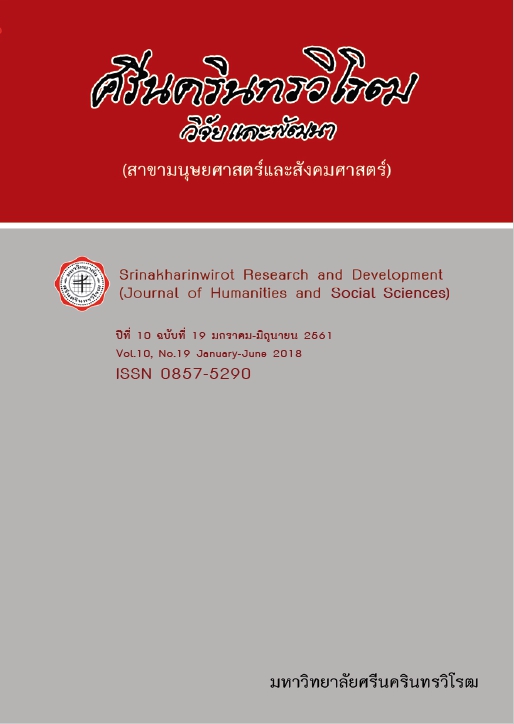กิจกรรมและเครือข่ายเศรษฐกิจชุมชน ตามปรัชญาเศรษฐกิจพอเพียง (SYSTEM AND COMMUNITY ECONOMIC NETWORK FOLLOWING THE SUFFICIENCY ECONOMY PHILOSOPHY)
Keywords:
Community Economy, Sufficiency Economy, Activities and NetworkAbstract
This study was a part of a research that aimed to promote concrete implementation of sufficiency economy through participatory learning process of community groups. Moreover, this paper also developed and increased competency. The study was conducted in Ban Pong 3, Intakhin Sub-District, Mae Tang District, Chiang Mai Province by using participatory action research. The results indicated that Ban Pong 3 had physical capital, human capital social capital and environment capital which were main factors of sustainable development.Besides, the economic activities of different community groups were concordant with the progressive sufficiency economy that emphasized the sufficiency at group or organization level. According to the potential development and network promotion, there was a cooperation between community, local developers and researchers to define targets and establish networks of sufficiency economy in various aspects such as production, marketing of OTOP products and community financial institutions. Observation visit was held to practice analysis process and prepare the business plan to the researchers to further vocational training or community development project. After that, the business plan was determined for production trial and market testing in the community until achieving satisfactory results.Then, the products were distributed to other community networks. Regarding the primary test results, therefore, it was highly feasible to shift the sufficiency economy to the third level as the progressive sufficiency economy which focused on the sufficiency at network level.
Downloads
References
[2] สถาบันไทยพัฒน์ มูลนิธิบูรณะชนบทแห่งประเทศไทย ในพระบรมราชูปถัมภ์. (2554). ระดับความพอเพียง. สืบค้นเมื่อ 23 กุมภาพันธ์ 2554, จาก http://sufficiencyeconomy.blogspot.com/2006/02/3.html
[3] ทรงศักดิ์ ศรีบุญจิตต์; และคณะ. (2551). โครงการประเมินผลเปรียบเทียบในมิติต่างๆ ของประชาชนในการนำหลักปรัชญาเศรษฐกิจพอเพียงมาประยุกต์ใช้. เชียงใหม่: คณะเศรษฐศาสตร์ มหาวิทยาลัยเชียงใหม่.
[4] ทศพล กฤตยพิสิฐ. (2554). กระบวนการมีส่วนร่วมของชุมชน. สืบค้นเมื่อ 23 กุมภาพันธ์ 2554, จาก http://www.bannongjik.com/cddforums/index.php?topic=230.0.html
[5] ประพีร์พร อักษรศรี. (2545). การวิจัยและพัฒนาระบบการจัดการเครือข่ายวิสาหกิจชุมชนภาคกลาง. ปทุมธานี: มหาวิทยาลัยราชภัฏวไลยอลงกรณ์ ในพระบรมราชูปถัมภ์.
[6] สุขุม พันธุ์ณรงค์; และคณะ. (2554). การพัฒนาธุรกิจชุมชนเพื่อความเข้มแข็งและยั่งยืน: กรณีศึกษาธุรกิจชุมชนในเขตภาคเหนือตอนบน. เชียงใหม่: คณะเศรษฐศาสตร์ มหาวิทยาลัยเชียงใหม่.
[7] อภิชัย พันธเสน. (2546). วิจัยและพัฒนาระบบการแลกเปลี่ยนชุมชนเพื่อการพึ่งตนเอง: เล่มที่ 1 บทสังเคราะห์. กรุงเทพฯ.
[8] อารี วิบูลย์พงศ์; และคณะ. (2552). การวิจัยและพัฒนาระบบการผลิตเกษตรและวิสาหกิจชุมชนตามวิถีเศรษฐกิจพอเพียง. เชียงใหม่: ศูนย์วิจัยเพื่อเพิ่มผลผลิตทางเกษตร คณะเกษตรศาสตร์ และคณะเศรษฐศาสตร์ มหาวิทยาลัยเชียงใหม่.
Downloads
Published
How to Cite
Issue
Section
License
Srinakharinwirot Research and Development Journal of Humanities and Social Sciences is licensed Under a Creative Commons Attribution-NonCommercial-NoDerivs 4.0 International (CC-BY-NC-ND 4.0) License, Unless Otherwise Stated. Please Read Journal Policies Page for More Information on Open Access, Copyright and Permissions.



